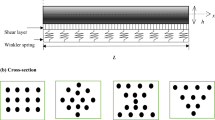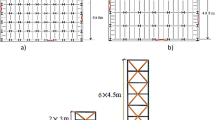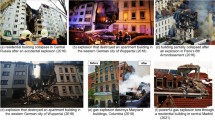Abstract
Occasionally steel structures are exposed to fire hazard during its lifetime. As temperature rises, the material characteristics of steel rapidly deteriorate, resulting in a loss in the flexural resistance of the beam members. For laterally unrestraint beams, lateral–torsional buckling (LTB) may predominate in design strength calculations. Beams may fail prematurely due to a rapid loss in capacity at elevated temperatures. Previous research has focused on employing a single equation to determine LTB design curves at elevated temperatures, with reduction factors. These curves may result in a very conservative design that might change with the loading patterns and can sometimes predict unsafe design strengths. The present manuscript carries out a parametric study using a validated numerical model. The robust computational software ABAQUS is used for simulating a total of 2940 elastic and inelastic beam models. A new proposal is recommended for predicting the design capacity for the uniform moment, moment gradients, point load at mid-span and uniformly distributed load considering monosymmetric sections at elevated temperatures. Further, a statistical study is conducted to ascertain the accuracy of the present proposal, and only 0.045 root mean square error is observed for new proposal. The resulted data are also compared with the available literature. The results show that the current proposal provides economical, safe and less scattered predictions with R2 > 0.95.

















Similar content being viewed by others
Abbreviations
- \(a, \, b, \, c\) :
-
New proposal constants
- \(b\) :
-
Width of the section
- \(B_{{\text{c}}} , \, B_{{\text{t}}}\) :
-
Top and bottom flange widths
- \(\alpha\) :
-
Imperfection factor
- \(E_{{\left( {20} \right)}}\) , \(E\) :
-
Elastic modulus at ambient temperature 20 °C
- \(T_{{\text{c}}} , \, T_{{\text{t}}}\) :
-
Top and bottom flange thickness
- \(f_{{{\text{y}},{ }\left( {20} \right)}}\), \(f_{{\text{y}}}\) :
-
Yield stress at ambient temperature 20 °C
- \(l\) :
-
Span length
- \(W_{{y,{\text{pl}}}}\) :
-
Section’s plastic modulus
- \(M_{{b,{\text{fi}},t}} ,_{{{\text{Rd}}}}\) :
-
LTB resistance moment
- \(h\) :
-
Section’s height
- \(I_{{{\text{ZC}}}}\), \(I_{{{\text{ZT}}}}\) and \(I_{Z}\) :
-
Second moment of area about the section z-axis of the top flange, bottom flange and the whole section
- \(\gamma_{{{\text{m}},{\text{fi}}}}\) :
-
Material partial safety factor in fire
- \(\Psi\) :
-
Moment gradients
- \(f\) :
-
Modification factor for \(\chi_{{{\text{LT}}}}\)
- \(\beta\) :
-
Severity factor
- \(k_{{\text{c}}}\), \(k_{{{\text{c}}1}}\) :
-
Correction factors for moment distribution
- \(\lambda_{{{\text{LT}}}}\) :
-
Non-dimensional slenderness for LTB
- \(\chi_{{{\text{LT}}}}\) :
-
Reduction factor for lateral–torsional buckling
- \(M_{{{\text{cr}}}}\) :
-
Elastic critical moment for lateral–torsional buckling
- \(\chi_{{{\text{LT}}\,{\text{fi}}}}\) :
-
The reduction factor for lateral–torsional buckling in the fire design situation
- \(\rho\) :
-
Degree of monosymmetry
- \(\lambda_{{{\text{LT}}\,{\text{fi}}}}\) :
-
Non-dimensional slenderness for LTB in fire
- \(\lambda_{{{\text{LT}}\,0}}\) :
-
Plateau length of LTB curves for hot-rolled steel sections
- \(\phi_{{{\text{LT}}}}\, \phi_{{{\text{LT}}\,{\text{fi}}}}\) :
-
Value to determine the reduction factor \(\chi_{{{\text{LT}}}}\)
- \(k_{{{\text{y}}\, \left( \theta \right)}}\),\(k_{{{\text{E}}\,\left( \theta \right)}}\), \(k_{{{\text{p}}\,\left( \theta\, \right)}}\) :
-
The reduction factor for the yield strength, elastic modulus and proportional limit of steel at the steel temperature \(\theta\)
- \(f_{{{\text{y}}\,{ }\left( \theta \right)}}\), \(f_{{{\text{p}}\,{ }\left( \theta \right)}}\),:
-
The effective yield strength, proportional limit of steel at the steel temperature \(\theta\)
- \(f_{{{\text{p}}\,{ }\left( {20} \right)}}\) :
-
Proportional limit of the steel at ambient temperature 20
- \(E_{{{ }\left( \theta \right)}}\),:
-
Proportional limit of the steel temperature \(\theta\)
- \(M_{{{\text{ult}}\, {\text{FEM}}}}\) :
-
Ultimate moment obtained from FEM
- \(M_{{{\text{ult}}\, {\text{Analytical}}}}\) :
-
Ultimate moment obtained from various formulations
- \(n\) :
-
Number of samples
- \(\overline{\chi }\) :
-
Mean of data
- \(\chi_{i}\) :
-
Ratio for comparing FEM to analytical values
- \(\chi_{{{\text{LT}}\,{\text{Analytical}}}}\) :
-
The reduction factor for LTB from analytical data
- \(\chi_{{{\text{LT}}\,{\text{EC}}3}}\) :
-
The reduction factor for LTB from Eurocode 3 formulations
- \(\chi_{{{\text{LT}}\,{\text{ref}}}}\) :
-
The reduction factor for LTB from reference formulations [28]
- \(\chi_{{{\text{LT}}\, {\text{New}}\;{\text{proposal}}}}\) :
-
The reduction factor for LTB from new proposal formulations
- \(\chi_{{{\text{LT}}\, {\text{FEM}},{\text{i}}}}\) :
-
The reduction factor for LTB from FEM individual data
- \(\overline{\chi }_{{{\text{LT}}\,{\text{ FEM}},{\text{i}}}}\) :
-
The reduction factor for LTB from FEM mean of individual data
- \(\chi_{{{\text{LT}}\,{\text{Analytical}},{\text{i}}}}\) :
-
The reduction factor for LTB from analytical individual data
- \(\chi_{{{\text{LT}}\,{\text{ FEM}}}}\) :
-
The reduction factor for LTB from FEM data
- \(\chi_{{{\text{modified}}\, {\text{fi}}}}\) :
-
Modified reduction factor
- \(\chi_{{{\text{LT}}\, {\text{fi}}\,{\text{New}} {\text{proposal}}}}\) :
-
LTB curve reduction factor for new proposal
- \(\chi_{{{\text{modified}}\, {\text{fi}}\,{\text{New}} {\text{proposal}}}}\) :
-
Modified reduction factor calculated from \(\chi_{{{\text{LT}}\, {\text{fi}}\,{\text{New}} {\text{proposal}}}}\)
References
Buchanan A, Moss P, Seputro J, Welsh R (2004) The effect of stress-strain relationships on the fire performance of steel beams. Eng Struct 26(11):1505–1515. https://doi.org/10.1016/j.engstruct.2004.05.003
Bureau of Indian Standards. SP 6(1): (1964) Handbook for Structural Engineers, 1. Structural Steel Sections
Chen L, Wang YC (2012) Efficient modelling of large deflection behaviour of restrained steel structures with realistic endplate beam/column connections in fire. Eng Struct 43:194–209. https://doi.org/10.1016/j.engstruct.2012.05.030
Couto C, Maia É, Vila Real P, Lopes N (2018) The effect of non-uniform bending on the lateral stability of steel beams with slender cross-section at elevated temperatures. Eng Struct 163:153–166. https://doi.org/10.1016/j.engstruct.2018.02.033
Couto C, Vila Real P, Lopes N, Zhao B (2016) Numerical investigation of the lateral–torsional buckling of beams with slender cross sections for the case of fire. Eng Struct 106:410–421. https://doi.org/10.1016/j.engstruct.2015.10.045
Dharma RB, Tan K-H (2007) Proposed design methods for lateral torsional buckling of unrestrained steel beams in fire. J Constr Steel Res 63(8):1066–1076. https://doi.org/10.1016/j.jcsr.2006.09.008
Dharma RB, Tan K-H (2007) Rotational capacity of steel I-beams under fire conditions Part II: Numerical simulations. Eng Struct 29(9):2403–2418. https://doi.org/10.1016/j.engstruct.2006.11.030
ENV 1993–1–1 (1992) Design of Steel Structures––Part 1–1. General Rules and Rules for Buildings, Commission of the European Communities (CEN), Brussels, Belgium
EN 1993-1-1 (2005) Eurocode 3 Design of Steel Structures-Part 1–1: General Rules and Rules for Buildings, European Committee for Standardization (CEN). Belgium, Brussels
EN 1993-1-2 (2005) Eurocode 3 Design of Steel Structures-Part 1–2: General Rules – Structural Fire Design, European Committee for Standardization (CEN). Belgium, Brussels
International Business Machines Corporation. (2022). IBM SPSS Advanced Statistics 28
ISO 834. (1999). ISO 834–1:1999 Fire resistance tests - Elements of building construction - Part 1: General requirements. International Organization for Standardization
Kucukler M (2020) Lateral instability of steel beams in fire: Behaviour, numerical modelling and design. J Constr Steel Res 170:106095. https://doi.org/10.1016/j.jcsr.2020.106095
Kumar A, Samanta A (2006) Distortional buckling in monosymmetric I-beams: reverse-curvature bending. Thin-Walled Struct 44(7):721–725. https://doi.org/10.1016/j.tws.2006.08.003
Kvålseth TO (1989) Note on Cohen’s Kappa. Psychol Rep 65(1):223–226. https://doi.org/10.2466/pr0.1989.65.1.223
Lopes N, Vila Real PMM (2014) Class 4 stainless steel i beams subjected to fire. Thin-Walled Struct 83:137–146. https://doi.org/10.1016/j.tws.2014.02.005
Samanta A, Kumar A (2006) Distortional buckling in monosymmetric I-beams. Thin-Walled Struct 44(1):51–56. https://doi.org/10.1016/j.tws.2005.09.007
Samanta A, Kumar A (2008) Distortional buckling in braced-cantilever I-beams. Thin-Walled Struct 46(6):637–645. https://doi.org/10.1016/j.tws.2007.12.004
Shakil S, Lu W, Puttonen J (2018) Response of high-strength steel beam and single-storey frame in fire: Numerical simulation. J Constr Steel Res 148:551–561. https://doi.org/10.1016/j.jcsr.2018.06.010
SIMULIA. (2017). Abaqus/CAE 6.17 User’s Manual. Dassault Systémes Inc. Providence, RI, USA, 1–1146
Suman S, Samanta A (2021) Behavior of laterally unsupported monosymmetric steel I-section beams at elevated temperature under non-uniform moments. Structures 33:3324–3356. https://doi.org/10.1016/j.istruc.2021.06.070
Taras A, Greiner R (2010) New design curves for lateral-torsional buckling-proposal based on a consistent derivation. J Constr Steel Res 66(5):648–663. https://doi.org/10.1016/j.jcsr.2010.01.011
Trahair NS (2012) Inelastic buckling design of monosymmetric I-beams. Eng Struct 34:564–571. https://doi.org/10.1016/j.engstruct.2011.10.021
Vila Real PM, Lopes N, Simões da Silva L, Franssen J-M (2004) Lateral-torsional buckling of unrestrained steel beams under fire conditions: improvement of EC3 proposal. Comput Struct 82(20–21):1737–1744. https://doi.org/10.1016/j.compstruc.2004.01.006
Vila Real PM, Piloto PA, Franssen J-M (2003) A new proposal of a simple model for the lateral-torsional buckling of unrestrained steel I-beams in case of fire: experimental and numerical validation. J Constr Steel Res 59(2):179–199. https://doi.org/10.1016/S0143-974X(02)00023-8
Vila Real PMM, Cazeli R, Simões da Silva L, Santiago A, Piloto P (2004) The effect of residual stresses in the lateral-torsional buckling of steel I-beams at elevated temperature. J Constr Steel Res 60(3–5):783–793. https://doi.org/10.1016/S0143-974X(03)00143-3
Vila Real PMM, Lopes N, Simões da Silva L, Franssen J-M (2007) Parametric analysis of the lateral–torsional buckling resistance of steel beams in case of fire. Fire Saf J 42(6–7):416–424. https://doi.org/10.1016/j.firesaf.2006.11.010
Wang CM, Kitipornchai S (1986) Buckling capacities of monosymmetric I-beams. J Struct Eng United States. https://doi.org/10.1061/(ASCE)0733-9445(1986)112:11(2373)
Wang CM, Kitipornchai S (1988) Buckling capacities of monosymmetric I-beams. J Struct Eng United States 114(3):739–740. https://doi.org/10.1061/(ASCE)0733-9445(1988)114:3(739)
Funding
The authors gratefully acknowledge the support and funding for the doctoral research work of the first author by Indian Institute of Technology Patna, India.
Author information
Authors and Affiliations
Corresponding author
Ethics declarations
Conflict of interest
We declare that we have no known competing financial interests or personal relationships with other people or organizations that could have appeared to influence the work reported in this paper.
Rights and permissions
Springer Nature or its licensor (e.g. a society or other partner) holds exclusive rights to this article under a publishing agreement with the author(s) or other rightsholder(s); author self-archiving of the accepted manuscript version of this article is solely governed by the terms of such publishing agreement and applicable law.
About this article
Cite this article
Suman, S., Samanta, A. Proposed design methodology for laterally unrestrained monosymmetric I-beams in fire. Innov. Infrastruct. Solut. 7, 367 (2022). https://doi.org/10.1007/s41062-022-00972-z
Received:
Accepted:
Published:
DOI: https://doi.org/10.1007/s41062-022-00972-z




